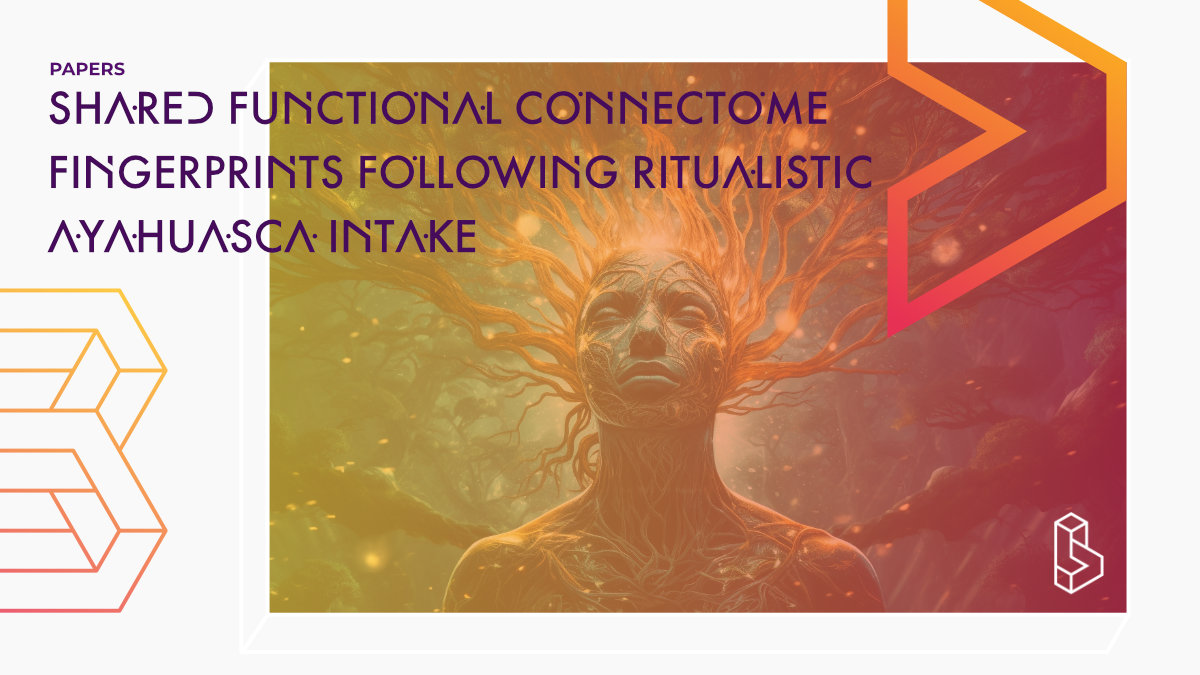This fMRI study (n=21) of people who regularly use ayahuasca within the Santo Daime church finds that during the experience, changes in functional connectivity (FC, how brain areas communicate) indicate on the scans more similarity between them (so less ‘unique’ FC). The authors use an analogy that each person still has their own hairstyle, but instead of wearing different coloured t-shirts, all are now wearing the same shirt.
Abstract of Shared functional connectome fingerprints following ritualistic ayahuasca intake
“The knowledge that brain functional connectomes are both unique and reliable has enabled behaviourally relevant inferences at a subject level. However, it is unknown whether such fingerprints persist under altered states of consciousness. Ayahuasca is a potent serotonergic psychedelic which elicits a widespread dysregulation of functional connectivity. Used communally in religious ceremonies, its shared use may highlight relevant novel interactions between mental state and FC inherency. Using 7T fMRI, we assessed resting-state static and dynamic FCs for 21 Santo Daime members after collective ayahuasca intake in an acute, within-subject study. Here, connectome fingerprinting revealed a shared functional space, accompanied by a spatiotemporal reallocation of keypoint edges. Importantly, we show that interindividual differences in higher-order FCs motifs are relevant to experiential phenotypes, given that they can predict perceptual drug effects. Collectively, our findings offer an example as to how individualised connectivity markers can be used to trace a subjects functional connectome across altered states of consciousness.”
Authors: Pablo Mallaroni, Natasha L. Mason, Lilian Kloft, Johannes T. Reckweg, Kim van Oorsouw, Stefan W. Toennes, Hanna M. Tolle, Enrico Amico & Johannes G. Ramaekers
Summary of Shared functional connectome fingerprints following ritualistic ayahuasca intake
Introduction
Functional connectivity patterns derived from fMRI data are stable across a lifetime and can be used to predict complex behavioural phenotypes such as cognition, demographics, traits such as fluid intelligence, and even clinical outcomes.
Recent work has demonstrated that an individual’s connectome fingerprint across sessions can be separated into signalling motifs reflecting both trait intra-subject and state-dependent inter-subject variance. These fingerprints may also reflect the temporal quality of functional network architecture.
Much work has been done to understand how the brain’s inherent connectivity may be differentially altered according to a particular individual or mental state, but there is little evidence bridging these lines of research. Altered states of consciousness may provide a new means to probe the interdependency of unique spontaneous brain activity and functional brain organisation.
The religious use of ayahuasca, a psychedelic brew produced by a combination of two different plant sources, might provide a useful means by which to investigate the orthogonality between trait and state FC under conditions in which an individual transitions from a normal, waking state of consciousness to a shared altered state.
Here, the authors sought to understand how ayahuasca brew consumption might alter a subject’s functional connectivity, and how this might explain aspects of their subjective experience.
Find this paper
Shared functional connectome fingerprints following ritualistic ayahuasca intake
https://doi.org/10.1016/j.neuroimage.2023.120480
Open Access | Google Scholar | Backup | 🕊
Study details
Compounds studied
Ayahuasca
Topics studied
Neuroscience
Study characteristics
Open-Label
Bio/Neuro
Participants
21
Humans
Authors
Authors associated with this publication with profiles on Blossom
Natasha MasonNatasha Mason is interested in elucidating the neurobiological and cognitive mechanisms of (psychedelic) drugs by utilizing multimodal study designs, with a particular focus on substances that may hold therapeutic value.
Johannes Ramaekers
Johannes Ramaekers is a professor at Maastricht University his work focuses on behavioral toxicology of drugs and combines methods from psychopharmacology, forensic toxicology and neuroscience to determine drug-induced changes in human performance. Some of this research is done with DMT.
Institutes
Institutes associated with this publication
Maastricht UniversityMaastricht University is host to the psychopharmacology department (Psychopharmacology in Maastricht) where various researchers are investigating the effects of psychedelics.
Compound Details
The psychedelics given at which dose and how many times
Ayahuasca 24 - 24mg | 1x

